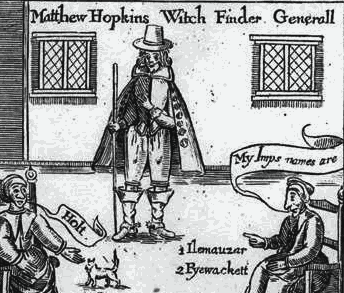- Screen Colours:
- Normal
- Black & Yellow

Witches in and around Suffolk" by Pip Wright
After a pause for the peak summer holiday period in August, our September talk was by Pip Wright. Pip is a retired primary school teacher, living in Stowmarket, who writes local history books, and gives talks to groups of all kinds and all ages across East Anglia. Together with his late wife Joy, who died in July 2005, he has spent a number of years gathering information on Suffolk’s social history. Visit Pip's website to read about his books and his other talks.
Setting a suitably eerie atmosphere with dimmed lights on a warm autumn evening in the United Reformed Church, Leiston, Pip Wright enthralled a large audience with tales of ‘Witches in and around Suffolk’.
In his own inimitable style, the retired primary school teacher and author of several local history books was at pains to stress that none of the subjects of his talk were endowed with magical powers. However, throughout the Middle Ages, white witches, working as herbalists and midwives, enjoyed the mysticism that surrounded them, and their skills were a cause of wonder. It was not until the 16th Century that their practices came to be viewed as posing a potential threat to others.
Pip was also quick to correct a common misconception. Contrary to popular belief, those found guilty of ‘witchcraft’ in England were not routinely burned at the stake. Although this was the practice in Scotland and parts of Europe, there was no law prohibiting witchcraft in England until 1563 and, even then, the Witchcraft Act only provided for death by hanging for those ‘who shall use practise or exercise any witchcrafte, enchantment, charme or sorcerie whereby any person shall happen to be killed or destroyed’.
When James VI of Scotland became King of England in 1603, he had already published a book on the subject, entitled "Daemonologie", and brought a deep suspicion and hatred of witchcraft South of the Border. Under his reign, the law intensified and merely attempting to conjure spirits was now construed as a capital offence.
Those brought to trial for witchcraft faced a range of tests designed to prove their guilt or innocence. Absurdly, one of these involved weighing the ‘accused’ against the large Bible kept in the parish church. If the Bible was heavier, it proved guilt. Perhaps the most famous ‘test’ was known as ‘swimming’, which involved trussing and ducking the ‘suspect’ in water. Those who sank were innocent, those who floated (a sign of rejection by baptismal waters) were deemed guilty.
In the mid 17th Century, England was plunged into Civil War and widespread hysteria fuelled the association of witchcraft with the devil or religious heresy. Capitalising on the chaos, the self-styled ‘Witchfinder General’, Matthew Hopkins of Manningtree, Essex, swept through Suffolk in 1645, bringing to trial at least 117 ‘witches and wizards’. Seven of those found guilty were hanged locally, in Aldeburgh.
Matthew Hopkins’ reign was short lived and, although ‘witch’ trials continued, more enlightened judges began to question the credibility of what was being presented to jurors as evidence. The last capital conviction for witchcraft in England is believed to have been in Hertfordshire in 1712. However, it wasn’t until 1736 that the legislation was repealed and, technically, imprisonment for practising witchcraft in England was still possible until 1951, when the Witchcraft Act was finally abolished.
For those interested in finding out more about witchcraft and our enduring fascination with the occult, Pip Wright’s book ‘Witches in and around Suffolk’ (pictured below), can be obtained via his website www.pipwright.com.
Chris Broom, September 2018
| |
|